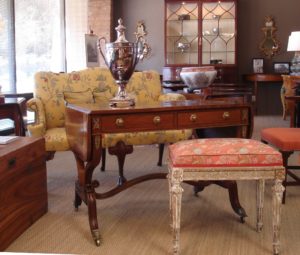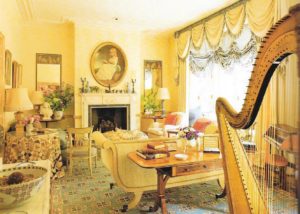With that query, everyone in England beyond the age of three would realize that the speaker was about to pour tea. Since the early years of the 19th century, tea service would have been the province of the lady of the house who was invariably wife and mother, perhaps not assisted, as would have been de rigueur a generation earlier, by a footman in livery to pass and carry.
It seems terribly formal all of this, but the early years of the 19th century saw the proliferation of a middle class, wealthy by the standards of today, but who nevertheless were without the army of servants that attended the aristocrats of an earlier day. That this lack of human buffers in the form of servants bred an informality in domestic comportment is easy to understand- one’s behavior was less driven by a fear of what the butler saw.

As intended- sofa table in front of a settee, with a silver tea urn.
As with so much else, change in circumstance, and change in social convention, likewise wrought a change- actually a development- in accoutrement. One such development was the sofa table, the ubiquitous element of every drawing room by the end of the first quarter of the 19th century. Designed to be placed in front of a sofa, it was of a height to allow for the pouring and service of tea while the hostess herself was conveniently, and demurely, seated. With parlour chairs near about easily pulled up to the sofa table, several people at once would be able to enjoy the late afternoon staple it would become by the end of the century. As it was invariably meant to float in front of a sofa, the sofa table is double sided, often with working drawers, meant originally to contain table linens and serviettes. Opposite the ‘business’ side are generally faux drawers, meant to provide a pleasing aspect to the piece for those viewing it from the front.

As used- behind a sofa, a casual bookshelf. Courtesy of Colefax and Fowler.
In the 20th century, though, the fashion gradually changed for low tables, so-called ‘coffee’ tables, to be placed in front of the sofa. Style of dress, and style of comportment, changed and the proliferation of soft furnishings made it possible to lounge about, comfortably bend over, and pick up a book, and set down a cup of coffee, cocktail glass, or champagne flute.
The sofa table, then, migrated to the rear of the sofa, serving most typically now as the support for a table lamp or two to provide illumination for those seated in front of it, and the side with the faux drawers, now of even less use than before, placed against the sofa. A side note- this now typical placement has, a century or so on, resulted in very many sofa tables sun faded on their ‘business’ side, but shielded from sunlight, retaining something close to their original, native colour on the reverse.
